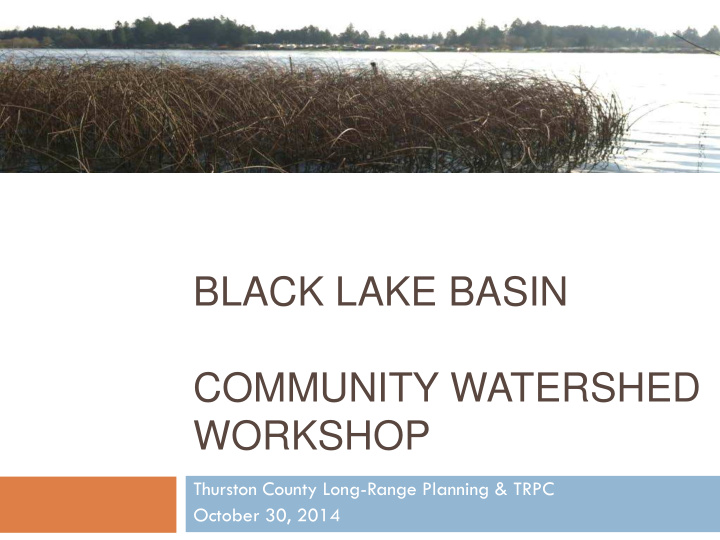



BLACK LAKE BASIN COMMUNITY WATERSHED WORKSHOP Thurston County Long-Range Planning & TRPC October 30, 2014
Tonight’s Agenda Welcome Presentation : Guiding Growth – Healthy Watersheds Project Background Alternative Land Use Scenarios Next Steps Table Discussions
Guiding Growth – Healthy Watersheds Project Background Thurston County is one of the fastest growing in Western Washington – How do we best protect water resources as our region grows? 2009: Thurston County and TRPC received a grant from EPA to conduct watershed-based planning
Guiding Growth – Healthy Watersheds Project Background Assessed current conditions for 69 basins April 2013: Selected 3 basins for focus McLane Creek (October 9 workshop) Black Lake Woodard Creek (October 22 workshop) 2013/2014: Gathered information and conducted analyses on each basin Now: Developing recommendations for future management
Where is the Black Lake Basin? ~ 5,000 acres (additional area occasionally drains to Black Lake) Jurisdiction Rural Thurston County Tumwater City and UGA Low density residential land use, open space and parks
What is the current condition of Black Lake Basin? Water Quality Ranking: Fair Elevated nutrient levels; blue-green algae blooms in lake 44% Tree Canopy Fish Pond Creek fails fecal coliform standard Habitat & Species Oregon Spotted Frog 8% Total Impervious Surfaces
What are the water resource concerns in Black Lake Basin? Population growth & development Water quality and algal blooms Nuisance aquatic species Shoreline vegetation & tree cover
Public Opinion Survey: Black Lake Summer 2013: Public survey sent by mail April 2014: Public meeting How concerned are you about water High level of concern quality in Black Lake Basin? about water quality Not at all concerned Important : Not very 6% concerned Clean drinking water 7% Puget Sound WQ Very Swimmable lakes and Neutral concerned 18% 42% streams Private property rights Concerned Healthy salmon runs 27%
Public Outreach Key Themes and Values Balancing urban growth while preserving less dense, rural lifestyle Protecting habitat for wildlife Improved water quality in lake Improved access to lake How would you hope to describe the Black Lake basin in thirty years? Much the same character as today, but improved water quality
Black Lake Basin: Draft Goals Maintain basin-wide ecological functions Protect (and improve) water quality Protect habitat for fish and wildlife Restore stream and shoreline functions where degraded Increase recreational opportunities
Alternative Land Use Scenarios Historic Conditions 1. Forested, with some prairie and wetlands Current Conditions 2. Current development, impervious surfaces, and stormwater Planned Future Trend 3. Current regulations carried out into the future Alternative Futures 4. Changes to land use and development regulations Restoration of riparian areas and wetlands Stormwater retrofits for older development
Alternative Land Use Scenarios Historic Current More than 15% Forest cover lost Some loss of wetland areas Changes from historic to current conditions greater than from future growth
Planned Trend Scenario VISION Black Lake Basin develops fully under current zoning, development, and stormwater regulations
Planned Trend Scenario: Outcomes Land Use More forest and agricultural areas are converted to residential ~4,000 additional dwelling units Total impervious area increases to 10% Fewer septics in higher risk areas as sewer lines are extended to urban areas Environmental Outcomes Bacteria levels in streams remain elevated and get worse in some areas Nutrient levels improve, as more homes are connected to sewer Habitat is fragmented by development
Future Alternative A VISION Black Lake Basin concentrates low- impact development, while maintaining sensitive open spaces in rural areas
Future Alternative A: Outcomes Land Use Fewer forest and agricultural areas are converted to residential ~340 fewer new dwelling units than Planned Trend Larger, undeveloped parcels zoned at lower density More protective policies along shorelines Impervious area slightly lower than Planned Trend Environmental Outcomes Stream temperatures and nutrients remain mostly the same as current conditions Bacteria and nutrient levels reduced in some areas Habitat connectivity better preserved
Future Alternative B VISION Black Lake Basin is a model for restoration through incentives, education, and investment in stormwater infrastructure
Future Alternative B: Outcomes Land Use Undeveloped parcels preserved through incentive programs, purchase of development rights Vegetation along shorelines restored Some wetland areas restored Education and outreach on pollution-reducing practices increased Total impervious area increases, but less than Planned Trend or Alternative A Environmental Outcomes Stream temperatures reduced significantly Bacteria and nutrient levels improved Benefits for a variety of aquatic species
Guiding Growth – Healthy Watersheds Next Steps Preferred Recommendations can include one of the future alternatives, mix and match from all three, or list new alternatives Final Report – Winter 2015 Public comment period Planning Commission Board of County Commissioners Credit: Neil Lindsey
Guiding Growth – Healthy Watersheds Next Steps Tonight Question & Answers Break for Table Discussions Dot voting
Guiding Growth – Healthy Watersheds Table Discussion Questions What goals and strategies are the most important to include in a final list of recommendations? What features in the alternatives would you want to see included? Which would concern you? What could be added?
Guiding Growth – Healthy Watersheds Contact Questions? Comments? Contact: Allison Osterberg Associate Planner Thurston County (360) 754-3355 x7011 osterba@co.thurston.wa.us
Recommend
More recommend